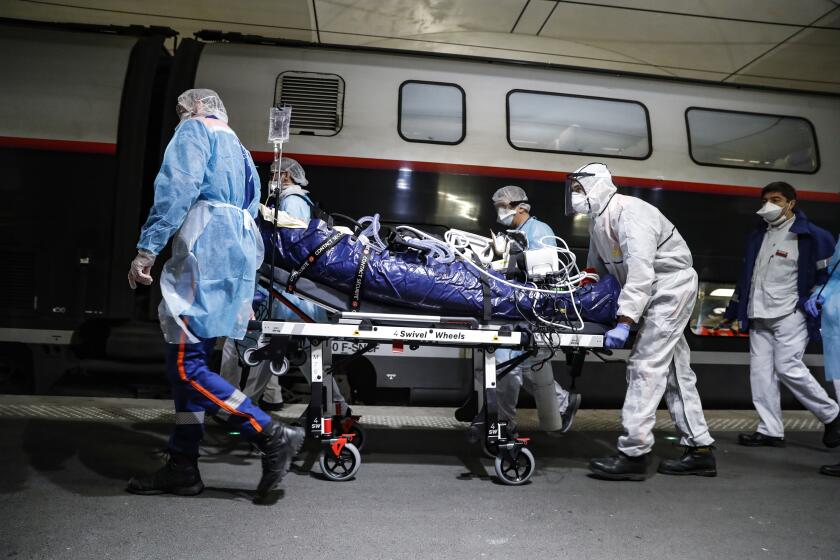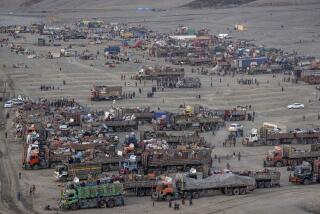Afghans flee home from coronavirus-stricken Iran, spreading the disease

- Share via
KABUL, Afghanistan — Mahdi Noori, a young Afghan refugee in Iran, was left jobless when the factory where he’d worked cutting stone was shut down because of the coronavirus outbreak. He had no money, was afraid of contracting the virus and had no options. So he headed home.
He joined a large migration of some 200,000 Afghans and counting who have been flowing home across the border for weeks — from a country that is one of the world’s biggest epicenters of the pandemic to an impoverished homeland that is woefully unprepared to deal with it.
At the border, Noori lined up with thousands of other returning refugees earlier this month, crowded together waiting to cross. “I saw women and children on the border, and I was thinking, ‘What if they get infected now, here?’” the 20-year-old told the Associated Press.
The massive influx of returnees — who are going back untested and unmonitored to cities, towns and villages around the country — threatens to create a greater outbreak in Afghanistan that could overwhelm its health infrastructure wrecked by decades of war. So far, Afghan authorities have confirmed 273 cases of the coronavirus, more than 210 of them in people who returned from Iran. Four deaths have been recorded.
Afghan Health Minister Ferozudin Feroz says the virus has already spread because of the returnees. “If the cases increase, then it will be out of control and we will need help,” he said.
He and other Afghan officials expressed concern that Iran would push out the more than 1 million Afghans working illegally in the country. Iran has already barred entry from Afghanistan, preventing any who left from coming back. Iran has had more than 58,000 coronavirus cases and more than 3,600 deaths.
So far, the International Organization of Migration has recorded more than 198,000 Afghans returnees from Iran this year, more than 145,000 of them in March as the outbreak in Iran accelerated. At the height of the influx, 15,000 people a day were crossing the border, according to Repatriation and Returnees Minister Sayed Hussain Alimi Balkhi, though it has gone down slightly since.
The coronavirus battle led the Alpini to build a field hospital in Bergamo, Italy.
At the border, the IOM gives tents and blankets to returnees who have nowhere to go and transportation money to others. But the Afghan government and independent agencies don’t have the capacity to test, take temperatures or quarantine the returnees. Almost all go back to their home provinces using public transportation, around a quarter of them to Herat province, bordering Iran.
Noori’s experience mirrors that of many other returnees.
He quit school to go work in Iran when he was 15, bouncing between multiple jobs, most recently cutting stone in a construction materials factory in the central Iranian city of Isfahan. He earned enough to send $180 a month back to his impoverished family of eight.
When the factory shut, he lost his income. He feared that, if infected, he would get no treatment because Afghans are far down in priority. He tried to get tested in Iran but was refused, he said.
He traveled back with other workers, not knowing if any of them were infected. Once in Afghanistan, he took buses across almost the entire breadth of the country to reach the capital, Kabul.
On the buses, he was met with hostility from other Afghans who told him, “Fear of coronavirus brought you home to kill others with it,” he said.
He reached his home in Kabul on March 17 and isolated himself for two weeks from his family, fearing he could infect them. “I experienced the worst moment of my life, meeting my parents, sisters and brothers from a distance after such a long time,” he said, speaking by phone from his home.
France is mobilizing high-speed trains, helicopters, jets and a warship to relieve congested hospitals and move coronavirus patients.
The government ordered a lockdown on March 28 in Kabul and Herat province, shutting down businesses, restaurants and wedding halls, just as the traditional spring season for weddings was beginning.
But the response has been hobbled by a government crisis in which two candidates claimed to have won recent presidential elections and by continued violence.
On Monday, neighboring Pakistan said it would reopen its border for four days so that Afghans wishing to return home can go back. On the other side of the border, which closed nearly a month ago, the Afghan government has set up a quarantine camp for the returnees.
Pakistani nationals stranded in Afghanistan will also be allowed to go back. According to the IOM, 1,827 Afghan refugees in Pakistan illegally had returned from there between Jan. 1 and mid-March.
Habibullah Zafari, who had been studying in Iran, returned to Kabul four weeks ago. The next day, he went to the testing center in the capital, where they didn’t test him but instead took his temperature and checked for symptoms. They declared him negative.
Nevertheless, Zafari quarantined himself until just a few days ago, when he finally met with friends and family. He still wears a mask and gloves and stays at home most of the time.
“This virus is like the wind,” he said. “You do not know where it comes from and how you get infected.”
More to Read
Sign up for Essential California
The most important California stories and recommendations in your inbox every morning.
You may occasionally receive promotional content from the Los Angeles Times.












